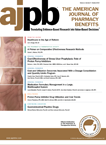Publication
Article
AJPB® Translating Evidence-Based Research Into Value-Based Decisions®
Healthcare in the Age of Reform
Author(s):
We have the opportunity to take what we learned in the 1980s and 1990s and create models of care that make sense for us all.
Human nature has shown us that when things are going well, there is little impetus to make changes. Only after things reach crisis point are we apt to evaluate options and opportunities. Increasing healthcare costs, a decreasing supply of primary care providers, and gaps in quality have created the need to examine how we deliver care within the United States. This is the environment that we fi nd ourselves in today.
Alternative care and payment models are being discussed and debated daily. Organizational structures termed “accountable care organizations” and “patient-centered medical homes” were front and center during the healthcare debate and have been written into healthcare reform legislation. These and other practice types are being established across the country. Although organizations such as the National Committee for Quality Assurance have established guidelines and foundational parameters that help to define these care groups, one thing remains true: There is no clear “winner” among care groups with respect to organizational structure or to how they can best meet the needs of all the stakeholders—patients, providers, payers, and society as a whole.
Many of these ideas and practice models are not new. In fact, they have existed for decades. In the 1980s, when I began to practice medicine, I worked within a staffmodel HMO. We practiced medicine as a team; a group of physicians with a variety of specialties, the nurses, the laboratory technicians, the psychologists, and the pharmacists all worked side by side and utilized the top of their licenses. The care was based on patient need. We shared the responsibility for evidence-based care, with the understanding that cost could be taken into consideration when choosing among equally effective options. Because our diagnostic options were limited compared with today’s standards, taking a patient’s history and other communication tools were more highly utilized. Many of these attributes can be found in the tenets of the “new” patient-centered medical home. For a period of time our practice of 120 providers was financed through capitation agreements, much like the “new” accountable care organizations are preparing to do.
I am not saying that we should not move forward with new models of care. Just the opposite. I believe we have the opportunity to take what we learned in the 1980s and 1990s and create models of care that make sense for us all. Let’s not waste this chance to put into place a high-quality, cost-effective model of care where patients get the care and support that they need, physicians once again enjoy caring for their patients, and we do not create a fiscal crisis that places employers and society at risk.







